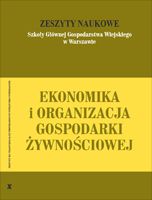Main Article Content
Article Details
BARRY P.J., ELLINGER P.N., BAKER C.B., HOPKIN J.A., 1995: Financial Management in Agriculture. Interstate Publishers, Inc., Danville, Illinois.
BEDNARSKI L., 2002: Analiza finansowa w przedsiębiorstwie. PWE, Warszawa.
CARPENTIER C., 2006: The valuation effects of long-term changes in capital structure. International Journal of Managerial, Finance, Vol. 2, No 1. (Crossref)
CZEKAJ J., DRESLER Z., 2005: Zarządzanie finansami przedsiębiorstw. Podstawy teorii. Wydawnictwo Naukowe PWN, Warszawa.
DĘBSKI W., 2005: Teoretyczne i praktyczne aspekty zarządzania finansami przedsiębiorstwa. Wydawnictwo Naukowe PWN, Warszawa.
FRANC-DABROWSKA J., 2006a: Zarządzanie kapitałem obrotowym a efektywność gospodarowania przedsiębiorstw rolniczych. Roczniki Naukowe SERiA, 8(1).
FRANC-DABROWSKA J., 2006b: Strategie kapitału obrotowego a efektywność przedsiębiorstw rolniczych. [W:] Finanse przedsiębiorstwa. Wydawnictwo UMCS w Lublinie, Lublin.
KRAJEWSKI M., 2006: Znaczenie kapitału pracującego w procesie kreowania wartości przedsiębiorstwa. [W:] Strategie wzrostu wartości przedsiębiorstwa. Teoria i praktyka. Zeszyty Naukowe nr 434, Prace Instytutu Ekonomiki i Organizacji Przedsiębiorstw nr 48, Wydawnictwo Uniwersytetu Szczecińskiego, Szczecin.
LEE W.F., BOEHLJE M.D., NELSON A.G., MURRAY W.G., 1988: Agricultural finance. Iowa State University Press/Ames, Iowa.
SIERPIŃSKA M., WĘDZKI D., 1997: Zarządzanie płynnością finansową w przedsiębiorstwie. PWN, Warszawa.
WASILEWSKI M., 2006a: Rentowność przedsiębiorstw rolniczych w zależności od strategii zarządzania kapitałem obrotowym. Roczniki Naukowe SERiA, 8(1).
WASILEWSKI M., 2006b: Efektywność i sprawność gospodarowania w przedsiębiorstwach rolniczych w zależności od strategii zarządzania kapitałem pracującym. [W:] Strategie wzrostu wartości przedsiębiorstwa. Teoria i praktyka. Zeszyty Naukowe nr 434, Prace Instytutu Ekonomiki i Organizacji Przedsiębiorstw nr 48, Wydawnictwo Uniwersytetu Szczecińskiego, Szczecin.
WĘDZKI D., 2003: Strategie płynności finansowej przedsiębiorstwa. Przepływy pieniężne a wartość dla przedsiębiorstwa. Wydawnictwo Oficyna Ekonomiczna, Kraków.
Downloads
- Mirosław Wasilewski, Serhiy Zabolotnyy, THE FORMATION AND EFFICIENCY OF THE FINANCIAL LIQUIDITY STRATEGY IN PKM DUDA S.A. , Zeszyty Naukowe SGGW - Ekonomika i Organizacja Gospodarki Żywnościowej: No. 64 (2008)
- Mirosław Wasilewski, Anna Wasilewska, EQUIPAGE AND EFFECTIVENESS OF MAKIN USE OF REAL CAPITAL ASSETS IN AGRICULTURAL ENTERPRISES , Zeszyty Naukowe SGGW - Ekonomika i Organizacja Gospodarki Żywnościowej: No. 66 (2008)
- Mirosław Wasilewski, Kinga Gruziel, Concept and Financial Effects of the Income Tax Implementation in Farms , Zeszyty Naukowe SGGW - Ekonomika i Organizacja Gospodarki Żywnościowej: No. 62 (2007)
- Mirosław Wasilewski, The Classification and Trends in Changes of Reserves in Private Farms , Zeszyty Naukowe SGGW - Ekonomika i Organizacja Gospodarki Żywnościowej: No. 48 (2003)
- Mariola Nabiałczyk, Mirosław Wasilewski, Method of Consolidation and Financial Standing of Capital Group , Zeszyty Naukowe SGGW - Ekonomika i Organizacja Gospodarki Żywnościowej: No. 58 (2006)
- Aleksandra Pisarska, Mirosław Wasilewski, Fixed assets management in enterprises of SME sector , Zeszyty Naukowe SGGW - Ekonomika i Organizacja Gospodarki Żywnościowej: No. 78 (2009)
- Mirosław Wasilewski, Teresa Domańska, The financial liquidity strategy in a view of harmonization of the ZT Kruszwica S.A. , Zeszyty Naukowe SGGW - Ekonomika i Organizacja Gospodarki Żywnościowej: No. 88 (2011)
- Mirosław Wasilewski, The Classification and Management of Reserves in Farming Entities , Zeszyty Naukowe SGGW - Ekonomika i Organizacja Gospodarki Żywnościowej: No. 54 (2004)
- Mirosław Wasilewski, Piotr Zabadała, Business Performance of Agricultural Enterprises vs. the Ratio of Equity to Liabilities , Zeszyty Naukowe SGGW - Ekonomika i Organizacja Gospodarki Żywnościowej: No. 99 (2012)
- Mirosław Wasilewski, Tendencies for Income Tax Burden on Individuals , Zeszyty Naukowe SGGW - Ekonomika i Organizacja Gospodarki Żywnościowej: No. 40 (2000)





